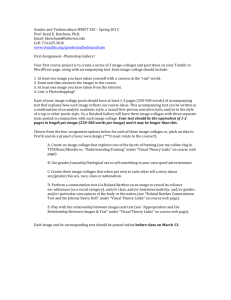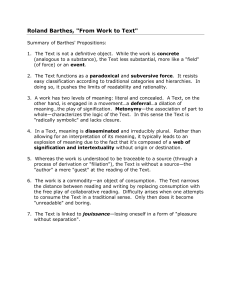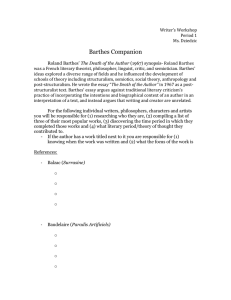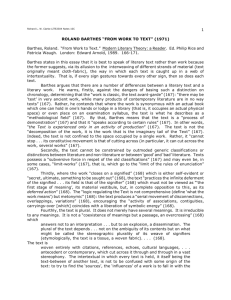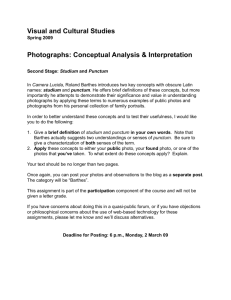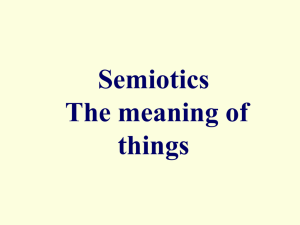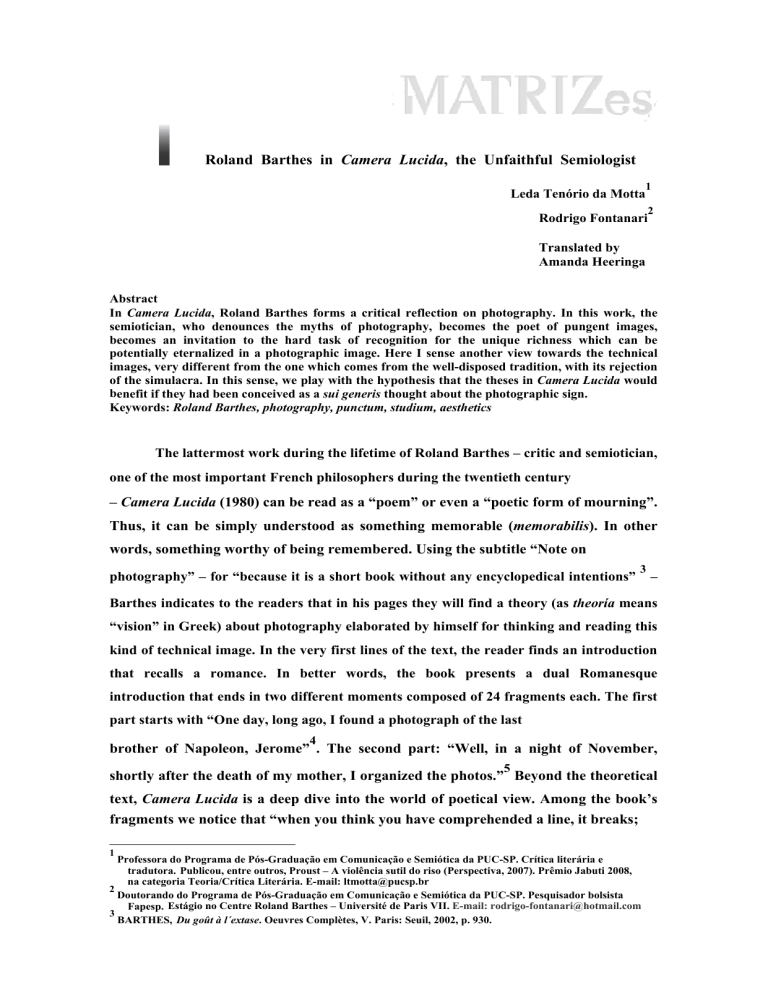
Roland Barthes in Camera Lucida, the Unfaithful Semiologist Leda Tenório da Motta 1 Rodrigo Fontanari 2 Translated by Amanda Heeringa Abstract In Camera Lucida, Roland Barthes forms a critical reflection on photography. In this work, the semiotician, who denounces the myths of photography, becomes the poet of pungent images, becomes an invitation to the hard task of recognition for the unique richness which can be potentially eternalized in a photographic image. Here I sense another view towards the technical images, very different from the one which comes from the well-disposed tradition, with its rejection of the simulacra. In this sense, we play with the hypothesis that the theses in Camera Lucida would benefit if they had been conceived as a sui generis thought about the photographic sign. Keywords: Roland Barthes, photography, punctum, studium, aesthetics The lattermost work during the lifetime of Roland Barthes – critic and semiotician, one of the most important French philosophers during the twentieth century – Camera Lucida (1980) can be read as a “poem” or even a “poetic form of mourning”. Thus, it can be simply understood as something memorable (memorabilis). In other words, something worthy of being remembered. Using the subtitle “Note on photography” – for “because it is a short book without any encyclopedical intentions” 3 – Barthes indicates to the readers that in his pages they will find a theory (as theoría means “vision” in Greek) about photography elaborated by himself for thinking and reading this kind of technical image. In the very first lines of the text, the reader finds an introduction that recalls a romance. In better words, the book presents a dual Romanesque introduction that ends in two different moments composed of 24 fragments each. The first part starts with “One day, long ago, I found a photograph of the last 4 brother of Napoleon, Jerome” . The second part: “Well, in a night of November, 5 shortly after the death of my mother, I organized the photos.” Beyond the theoretical text, Camera Lucida is a deep dive into the world of poetical view. Among the book’s fragments we notice that “when you think you have comprehended a line, it breaks; 1 Professora do Programa de Pós-Graduação em Comunicação e Semiótica da PUC-SP. Crítica literária e tradutora. Publicou, entre outros, Proust – A violência sutil do riso (Perspectiva, 2007). Prêmio Jabuti 2008, na categoria Teoria/Crítica Literária. E-mail: ltmotta@pucsp.br 2 Doutorando do Programa de Pós-Graduação em Comunicação e Semiótica da PUC-SP. Pesquisador bolsista Fapesp. Estágio no Centre Roland Barthes – Université de Paris VII. E-mail: rodrigo-fontanari@hotmail.com 3 BARTHES, Du goût à l´extase. Oeuvres Complètes, V. Paris: Seuil, 2002, p. 930. 4 - Ibid. La chambre claire. Oeuvres Complètes, V. Paris: Seuil, 2002, p. 791 161 Vol6 Nº 1 and 2.July/December 2012 – São Paulo – Brasil – Leda Motta – Rodrigo Fontanari – p.161 -168 when you believe having matured concepts or methods, you only find beautiful useless objects in your hands once more, without any function considering they are 6 collected from their own systems.” Camera Lucida is not a poetical labyrinth which fractures any attempt of comprehension of the text as a theory of photography’s semiotics or of the photographic portrait. Perhaps Leyla Perrone-Moisés is right afresh when in La Langage de Roland Barthes asserts that: There’s nothing more depressing than seeing Barthes’ texts being considered intellectual objects, find them summarized, analyzed and discussed from the viewpoint of their scientificity, their heuristic value, from their methodological contribution, from their political engagement. Nothing more depressing than seeing this reflection being interrogated as a thought, this interpellated voice as the voice of an individual, 7 this director conceived as a professor, this author being read as if he was a writer. Reading all Barthes’ works, we can draw a subtle theory of photography, a 8 way of reading this kind of technical image from the oppositional pair obvious/obtuse – developed in his article about photograms of S. M. Einstein, The Third Meaning: research notes on some Einstein’s stills –, or even the already classic concepts of 9 studium/punctum , established in Camera Lucida. All of this does not seem to sustain a theoretical scope for it is possible to assuredly affirm that there is some kind of “semiotics” or “semiology of photography”, in the strict sense of the dictionaries of semiotics. In Handbook of Semiotics, Winfried Nöth highlights that the terms semiotics 10 and semiology and structuralism have been conceived as almost synonyms . Let us examine the definitions established by Algirdas, Julien Greimas and Joseph Cortés in Sémiotique: dictionnaire raisonné de la théorie du langage for the entries: Semiology – The semiotic project, considering there is a search for its development in the narrow Saussurean definition frame (and that it was out of any contact with the epistemology of human sciences of that period) – the ‘system’, apart from the semiotic process and, none the less, the most diverse meaningful practice; the study of ‘signs’, part of the theory of communication, consisting in the almost mechanical use of the 5 Idem; p. 841. PERRONE-MOISÉS, Leyla. La langage de Roland Barthes. In La Quinzaine Littéraire, n. 191, Paris, juillet 1974. 7 - Ibid; p. 23. 8 The term “obvious”, etymologically “that which comes ahead” refers to what is naturally presented, to the meaning constructed by the representation; obtuse is the “too much”, which “my intellection cannot absorb well, simultaneously stubborn and fugitive (…)” (OC, III, p.489- 492). 6 9 Studium is the field of study, “qui ne veut pas dire, du moins tout de suite, l´étude, mais l´application à une chose, le goût pour quelqu´un, une sorte d´investissement général empressé certes, mais sans acuité particulière.” (OC, V, p. 899); Punctum is the place of sentimentalities, a section of time and space, where it is deposited a whole moment of emotion. In the words of Barthes, “punctum of a photograph is this moment in which, in the photograph, it stings me (but also mortifies me, hurts me)” (OC, V, p. 809). 10 - NÖRTH, Winfried. A semiótica no século XX. São Paulo: Annablume, 2001. 162 Vol6 Nº 1 and 2.July/December 2012 – São Paulo – Brasil – Leda Motta – Rodrigo Fontanari – p.161 -168 11 model of ‘linguistic sign'. Semiotics – Can be used with different meanings, considering it designates any expressed measurement which an individual is willing to know; an object of knowledge, as it appears and then its description combined to the group of ways 12 that make its acknowledgement possible. The term ‘semiotics’ (from Greek ‘semeiotike’) comes from ‘semion’ (sign). In a philosophical and logical sense, semiotics presents itself as a general theory of signs and its articulations in the thought. By the semiological bias, the word assumes the sense of a theory of the signs or senses and its social articulations. Oswald Ducrot and Jean-Marie Schaeffer, in the Nouveau Dictionnaire Encyclopédique des Sciences du Langage, highlight that the term ‘semiotics’ or ‘semiology’ is the study of signs and the interpretative processes. Also, this reflection about the signs is not recent, but recalls the Ancient Greek definition. It is from the philosopher John Locke that the term ‘semiotics’ definitively arises, conceived as ‘knowledge of the signs’, sign as relationship of reference for a noticed event. 13 In a broad way, semiotics is understood as thought about language, a science that studies all cultural phenomena as they were sign systems, based on the hypothesis in which all cultural phenomena are sign systems. In other words, culture is essentially communication and semiotics or semiology would consequently be “the science that 14 studies the life of signs in the bosom of social life”. On the other hand, as researchers of Barthes, we cannot deny all his efforts to construct some kind of semiology or semiotics in the mid 1960’s. Many of his works mark his way and his involvement in this “science of signs in social life”, starting with the important manual of linguistic technical terms, Elements of Semiology. After that he had his efforts towards the semiological research in The Fashion System, which we can consider the closest work to the Hjelmslevian semiotics, as well as the analysis of narration in S/Z. All of these things exclusively mention some of the incursions of this French intellectual in the strict area of French semiology, period most considered 11 GREIMAS, A. J.; CORTÉS, J.. Sémiotique: dictionnaire raisonné de la théorie du langage. Paris: Hachette, 1993, p. 336. 12 Ibid.; p. 339. 13 DUCROT, Oswald; SCHAEFFER, Jean-Marie. Nouveau dictionnaire encyclopédique des sciences du langage. Paris: Seuil, 1995. p. 214. 163 Vol6 Nº 1 and 2.July/December 2012 – São Paulo – Brasil – Leda Motta – Rodrigo Fontanari – p.161 -168 structuralist. It is known that in the 1970’s, Barthes gradually veered from the universe of technical terms and having new epistemological experiences, because for him the scientific researches have become a set of indifferent and undifferentiable works in relation to his corpus. This indifference was clearly highlighted by Barthes in Roland Barthes by Roland Barthes, in the fragment “Dramatized Science”, under the “condition said as the corpus in the body (…); it shall be searched not only the structure but the figure of enunciation: it is desirable to have any kind of loving relation with this group, (considering that the corpus 15 it is nothing more than a scientific imaginary).” The Barthesian displacement, in the sense of reclaiming the body in science, indicates that he did not have the pretention of being a theorist of the linguistic sign, nor a projection of the shadow of the science of the sign (semiology) or even a scientific domain in which his followers could hostage their diverse themes and research objects. However, he was very loyal to a single unique principle: the pleasure of writing 16 (writerly) , which motivated Leyla Perrone-Moisés to say “it is writerly that burns 17 the letters and before these letters is where linguists retreat” From this semiotician who claims the joys of writerly, there was nothing left but the political individual, who saw in language (“I see the language”) 18 an instance of power that made him say - in his inaugural lecture of Literary Semiology at the College de France in 1977 - that the language (…) is simply 19 fascist, because fascism does not impede from saying, it obliges someone to say.” In this sense, the work of the semiotician Roland Barthes was directed in an attempt to fight the problematics of the linguistic sign. This fight only made him willing to confront the sign under its most utopic form: empty. In the words of Barthes himself, 14 SAUSSURE, Ferdinand. Cours de linguistique générale. Paris: Payot, 1972, p. 33. 15 - BARTHES, Roland. Roland Barthes par Roland Barthes. Oeuvres Complèts, IV. Paris: Seuil, 2002, p. 735. Here, it is suitable to have an explanation of the terms readerly and writerly in Barthes. Readerly differs from writerly because writerly refers to a notion in which writing has a value in itself, an intransitive writing in which the importance is in the semiotical praxis, in a work of and with words, whereas readerly has no value apart from its content. A transitive writing id the one in which expression is in talking about something, or someone, in its content. Cf. Idem; Écrivains, intellectuels, professeurs. Oeuvres Complèts, III. Paris: Seuil, 2002. Idem.; La preparation du roman. Paris: Seuil- IMEC, 2004. 17 - PERRONE-MOISÉS, Leyla; Op. cit. p. 23. 18 Cf. BARTHES, Roland. Roland Barthes par Roland Barthes. Oeuvres Complètes, IV. Paris: Seuil. 2002, p. 735. 16 19 - Idem.; Leçon. Oeuvres Complètes, V. Paris: Seuil, 2002, p. 432. 164 Vol6 Nº 1 and 2.July/December 2012 – São Paulo – Brasil – Leda Motta – Rodrigo Fontanari – p.161 -168 “Someone who struggled during a lifetime, for the good and for the bad, this diablerie, the language, can only be fascinated by the forms of its emptiness – than 20 the absolute opposite of its emptiness” 21 This work with the sign (literature) 22 meaning) and the counter-sign (absence of constructed by Barthes subverts the Saussurean concept of the sign: 23 the link between the signifier (acoustic image) and the signified (concept) . By willing to have an empty form, he tries to annul the meaning over a pure signifier. “He visibly dreams of a world which would be meaning-free (as some kind of military service). This idea started with the Degree Zero, in which one aspires the absence of any type of sign; then, a thousand affirmations about this dream (about 24 the vanguard text, Japan, music, alexandrine etc)” The conception of the sign desired by Barthes does not seem to be acceptable for a Saussurean linguist, just as much as it would be impossible for a Hjelmslevian to think about the sign as a sign of something or expression of a content. Barthes was “dreaming big” – expression used by himself in the Collége France – with an idea of the sign which meets his concept of neutral, understood as all inflexions which divert from the paradigmatic structure of meaning, aiming for the suspension of the conflicting information of the discourse. Figures of the Neutral: white writing, exempt of any literary theatre – Adamic language – delectable insignificance – the plain – the empty – the seamless (…) the absence of imago – the suspension of judgment, of process (…) the joy: all avoidance, disarticulates the exhibition, the domain, the intimidation or makes them all derisive. 25 This “second Barthes” does not seem to look into the net of articulations of the forms anymore. Previously, he tries to explore the sign and even classifies it, as an example of what he did before in Camera Lucida. By positioning himself as a savage in 20 - BARTHES, Roland. Leçon. Oeuvres Complètes, V. Paris: Seuil, 2002, p. 441. 21 Roland Barthes presents in his inaugural lecture a particular notion of literature, a possible instance of possibly cheating on language and cheating with language: “this salutary trickery, this evasion, this wonderful imposture which allows us to hear speech outside the domains of power, in the splendor of a permanent revolution of language, I for one call it literature” BARTHES, Roland. Leçon. Oeuvres Complètes, V. Paris: Seuil, 2002. p. 433. 22 This notion of absence of meaning would be close to emptiness. A clearer way of exemplifying would be the act of listening to a language whose meaning we do not understand. For us, these sounds would be pure substance, using Hjelmslevian terms, or even the “pure significance, infinite without depth” COMMENT, Bernard. Roland Barthes vers le Neutre. Paris: Christian Bourgois Éditeur, 2002, p. 75. 23 - Cf. SAUSSURE, Ferdinand. Cours de linguistique générale. Paris : Payot, 1972. 24 - BARTHES, Roland. Roland Barthes par Roland Barthes. Oeuvres Complètes, IV. Paris: Seuil, 2002, p. 25 664. - Ibid. ; p. 707. 165 Vol6 Nº 1 and 2.July/December 2012 – São Paulo – Brasil – Leda Motta – Rodrigo Fontanari – p.161 -168 front of the photographic image, Barthes observes the photographic sign as emanation of referent: “(…) Photography always brings its referent with itself (…) they are stuck together, member by member as the condemned tied to a corpse in certain types of 26 torture . Therefore it is an evidentiary image in the Peircean conception of the term, maintaining an existential connection with the object. For the photographed image of an individual to be under the metallic sheet of the photography, it is necessary that there is a connection between the photographed person and the silver nitrate. However, the photographic record is not the person. It only indicates, according to the specific inherent limits of photography. Photography is a specific intersection in time and space. The image that was put under the surface of the metallic sheet acts like an icon of the individual because it is the result of a real connection between the shot and the individual (it was necessary that the person existed and it was necessary that the person was in front of the 27 lens for the photographic image to be revealed) . In this sense, Roland Barthes positions the “referent” in scene, which would be inacceptable for semiotics or semiology based on the Saussurean linguistics. In the Saussurean linguistics the exclusion of the referent is a 28 necessary condition. Barthes, in the condition of an “impure fellow” , as he defines in his inaugural class in College de France, mixes and displaces concepts of French semiotics, originated from the structuralist Saussurean linguistics and in the other hand also from the American semiotics established by Charles Sander Peirce. This distinction makes accommodating the term “semiotics” comfortably difficult in the Barthesian works post 1970 (if not in a broad conception of a general theory of the modes of signifying and signification), especially in Camera Lucida, in which the poetical language overshadows any attempt of “revealing” a semiotic model of reading for the photographic images, except for a subtle inscription suggested by the opposites Studium/Punctum. The 48 effulgent fragments of this book configure an aesthetical reflection about the photographic sign, with quick brushstrokes of a semiotical or semiological perspective, capable of observing nature from this technical representation. An aesthetical reflection in the 26 - Idem; La chambre claire. Oeuvres Complètes, V. Paris: Seuil, 2002, p. 27 793. - Cf. DUBOIS, Philippe. L´acte photographique. Paris: Nathan, 1990. Cf. SANTAELLA, Lucia ; WINFRIED, Nöth. Imagem: cognição, semiótica e mídia. São Paulo: Iluminuras, 2005. 28 - BARTHES, Roland. Leçon. Oeuvres Complètes, V. Paris: Seuil, 2002, p. 429. 166 Vol6 Nº 1 and 2.July/December 2012 – São Paulo – Brasil – Leda Motta – Rodrigo Fontanari – p.161 -168 conception of the Greek term whose origins are in a verb translated by “to feel”. In other words, a science which conceives beauty with a confusing perception or feeling. In a freer comprehension, the aesthetics as what passes through the body, which causes fruition (pleasure). Perhaps we would be better if we conceived this book from a philosophical and aesthetic perspective of photography. For the rest, it is Barthes himself who allows us to read Camera Lucida from another viewpoint, without forcing it in order to extract a semiotical theory of photography. At the time of publication of the book, Barthes is invited for an interview in which he highlights: “(…) It is not sociology nor aesthetics or a story of a photo. It is, above all, a phenomenology of photography.” 29 Even though this short excerpt from the interview denies the possibility of an aesthetic of photography, the reading of the entirety in Oeuvres Complètes impels us to visualize a project around an idea of the sign that extrapolates the linguistic and semiotical field, which seems to be closer to an aesthetical idealization of the emptiness of the signs than the photographic field would be denominated under the concept of punctum or obstuse, keeping the Barthesian nomenclature. If after 1970 the Barthesian writerly does not comprehend the arrogance of the scientific discourse, it is because it slips to “the aesthetical discourse”, a symptom that Barthes introduces to the public in Roland Barthes by Roland Barthes. He tries to develop a discourse that does not enunciate itself in the name of Laws and/or Violence: a discourse whose instance is not political nor religious or scientific; a discourse that is, in a certain way, the rest and the supplement of all this enunciations. How would we call this discourse? Erotic, doubtlessly, because it relates to pleasure; perhaps even: aesthetical, if we previse subordinating this old category gradually to a light distortion, which will repel it 30 from its regressive depths, idealist, and will approximate the body of drift. Camera Lucida – which we could consider the last Barthesian incursion on photography is a work of writerly that has, in the beginning, a beautiful questioning: to know at any cost what this image “by itself” is. Camera Lucida is a work of research about the photographic sign, much closer to the aesthetics of the photographic image and what differentiates it from the other kind of images. By the own hands of Barthes 29 - BARTHES, Roland. Sur la photographie. Oeuvres Complètes, V. Paris: Seuil, 2002, p. 934. 30 - Idem; Roland Barthes par Roland Barthes. Oeuvres Complètes, IV. Paris: Seuil, 2002, p. 661. 167 Vol6 Nº 1 and 2.July/December 2012 – São Paulo – Brasil – Leda Motta – Rodrigo Fontanari – p.161 -168 we have: In relation to photography, I was taken by an “ontological” desire: I wanted to know at any cost what the photography was “in itself”; by what essential feature it would be distinguished from the community of images. A desire like this meant that, deep inside, out of the evidences that come from technique and from the use and despite its formidable contemporary expansion, I was not sure that 31 Photography existed, that it disposed of a “genius” of its own. This aesthetics of emptiness is still to be elaborated, but it seems progressively more evident that all of the Barthesian project of writerly – from Degree Zero to The Preparation of the Novel, passing by Neutral –, is done through the search for the empty form. Notedly, Philippe Forest in Le Temps Retrouvé de Roland Barthes, published in Arc magazine, highlights the necessity of “(…) trace the genealogy, 32 interrogate the limits – enhance the problematics of meaning and its suspension” It is sufficient, for now, to indicate that there is a possibility to develop the construction of this conception of sign and its epistemological basis, which would be an enormous contribution to the arts in general. Therewith, we believe that the title of this Barthesian work could have been Camera Lucida – Notes for an aesthetic of the photographic sign. REFERENCES BARTHES, Roland. Oeuvres Complètes. Paris: Seuil, 2002. COMMENT, Bernard. Roland Barthes vers le Neutre. Paris: Christian Bourgois Éditeur, 2002, p. 75. DUBOIS, Philippe. L´acte photographique. Paris : Nathan, 1990. FOREST, Phillipe. Le temps retrouvé de Roland Barthes. In: Arc, Paris, 1996. GREIMAS, Algirdes Julien; CORTÉS, Joseph. Sémiotique: dictionnaire raisonné de la théorie du langage. Paris : Hachette, 1993. PERRONE-MOISÉS, Leyla. La langage de Roland Barthes. In : La Quinzaine Littéraire. n. 191, Paris, juillet 1974. SANTAELLA, Lucia ; Winfried, Nöth. Imagem: cognição, semiótica e mídia. São Paulo: Iluminuras, 2005. SAUSSURE, Ferdinand. Cours de linguistique générale. Paris: Payot, 1972. NÖTH, Winfried. A semiótica no século XX. São Paulo: Annablume, 2001. This text was received at 13 December 2011 and accepted at 27 January 2012. 31 32 - Idem.; Leçon. Oeuvres Complètes, V. Paris: Seuil, 2002, p. 791. - FOREST, Phillipe. Le temps retrouvé de Roland Barthes. In: Arc, Paris, 1996, p. 60. 168 Vol6 Nº 1 and 2.July/December 2012 – São Paulo – Brasil – Leda Motta – Rodrigo Fontanari – p.161 -168 PDF to Word
